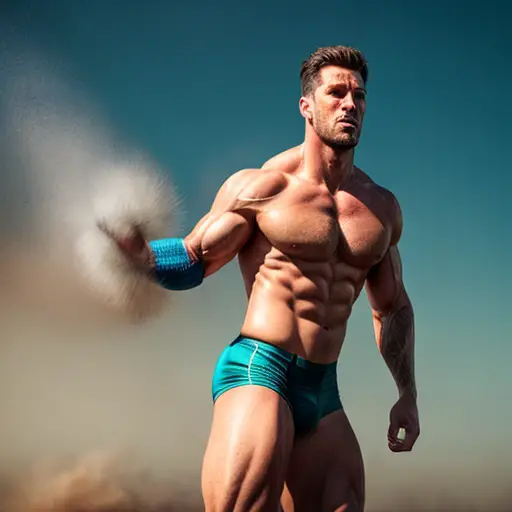The Powerhouse Players - Understanding the Key Muscles in Volleyball
Alright, fellow volleyball enthusiasts, let's dive into the world of muscles that make those powerful spikes and gravity-defying digs possible! When it comes to the powerhouse players of the volleyball court, we can't ignore the key muscles that work tirelessly behind the scenes. Picture this: your glutes, those buns of steel, are the driving force behind those explosive jumps that leave your opponents in awe. Meanwhile, your quads, those mighty tree trunks, provide the stability and strength needed to maneuver swiftly across the court. And let's not forget about your core, the unsung hero that keeps you balanced and poised during those intense rallies. So, next time you're out there spiking like a boss, remember to give a nod to these unsung MVPs – your glutes, quads, and core – the true powerhouse players of the volleyball game!
Serving Up Strength - Unveiling the Muscles Involved in Serving and Spiking
An interesting fact about the muscles used in volleyball is that the sport engages a wide range of muscles throughout the body. While many people may assume that volleyball primarily targets the upper body muscles, such as the shoulders and arms, it actually involves a significant amount of lower body strength and core stability. The muscles used in volleyball include the deltoids, triceps, biceps, pectorals, and forearm muscles for hitting, serving, and blocking. Additionally, the quadriceps, hamstrings, glutes, and calf muscles are heavily engaged for jumping, quick lateral movements, and explosive power. The core muscles, including the abdominals and lower back, play a crucial role in maintaining balance, stability, and generating power for various movements on the court.
Ladies and gentlemen, get ready to serve up some serious strength as we unveil the muscles that fuel those killer serves and jaw-dropping spikes! First up, let's talk about the triceps, the unsung heroes of the serving game. These bad boys provide the power and control needed to launch that ball over the net with lightning speed. And what about those shoulder muscles? They're the real MVPs when it comes to spiking, generating the force necessary to send that ball crashing down on the opponent's side. Last but not least, let's not forget about the wrist flexors, the secret weapons behind those wickedly deceptive shots that leave defenders scratching their heads. So, next time you step onto the court, remember to give a shout-out to your triceps, shoulders, and wrist flexors – the true champions of serving and spiking in the world of volleyball!
Setting the Stage - Exploring the Muscles Essential for Accurate Setting

Get ready to set the stage for precision and finesse as we delve into the muscles that are essential for accurate setting in the game of volleyball. First and foremost, let's talk about the finger flexors, those tiny yet mighty muscles that allow you to delicately control the ball's trajectory. These muscles work in harmony to provide the delicate touch needed to set the ball with pinpoint accuracy.
Next up, we have the forearm muscles, the unsung heroes of setting. These muscles, including the flexor carpi radialis and the extensor carpi radialis, provide the strength and stability required to execute those quick and precise sets. They allow you to generate the perfect amount of force to send the ball soaring towards your teammate, setting them up for a killer attack.
Now, let's not forget about the shoulder muscles, particularly the rotator cuff muscles. These muscles, including the supraspinatus, infraspinatus, teres minor, and subscapularis, play a crucial role in setting. They provide the stability and control needed to accurately position the ball, ensuring that it reaches its intended target with finesse.
Last but certainly not least, we have the core muscles. While they may not be directly involved in the act of setting, a strong core is essential for maintaining balance and stability during the setting motion. The rectus abdominis, obliques, and transverse abdominis all work together to provide a solid foundation, allowing you to execute those picture-perfect sets with ease.
So, the next time you witness a flawless set on the volleyball court, remember to appreciate the hard work of the finger flexors, forearm muscles, shoulder muscles, and core. These muscles are the true MVPs when it comes to setting the stage for success in the game of volleyball.
Digging Deep - Unraveling the Muscles Behind Effective Digging and Blocking
A fun fact about muscles used in volleyball is that players heavily rely on their core muscles, including the abs and lower back, to maintain balance and stability while performing various movements such as jumping, diving, and changing directions quickly on the court.
Get ready to dig deep and unravel the muscles that are essential for effective digging and blocking in the game of volleyball. Let's start with the lower body powerhouse, the quadriceps. These muscles provide the explosive power needed to quickly react and get low to the ground for those impressive digs. They allow you to spring into action and dig those hard-hitting spikes with precision and control.
Next up, we have the glutes, the unsung heroes of digging and blocking. These muscles not only provide the power to explode off the ground but also help stabilize your body as you dive and slide to make those incredible saves. They are the driving force behind your defensive prowess, allowing you to dig deep and keep the ball in play.
Now, let's not forget about the upper body muscles, particularly the shoulder and arm muscles. The deltoids, rotator cuff muscles, and triceps all work together to generate the strength and control needed to execute those powerful blocks. They allow you to reach high above the net and shut down your opponents' attacks with authority.
Last but certainly not least, we have the core muscles. A strong core is essential for maintaining balance and stability during digging and blocking movements. The abdominal muscles, obliques, and lower back muscles all play a crucial role in keeping you steady and in control as you dig deep and unleash your blocking skills.
So, the next time you witness a jaw-dropping dig or a game-changing block, remember to give credit to the quadriceps, glutes, shoulder and arm muscles, and core. These muscles are the true champions when it comes to digging and blocking in the game of volleyball.

